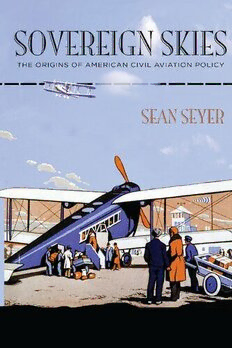
Sovereign Skies: The Origins of American Civil Aviation Policy PDF
Preview Sovereign Skies: The Origins of American Civil Aviation Policy
Sovereign Skies HAGLEY LIBRARY STUDIES IN BUSINESS, TECHNOLOGY, AND POLITICS Richard R. John, Series Editor Sovereign Skies The Origins of American Civil Aviation Policy Sean Seyer JOHNS HOPKINS UNIVERSITY PRESS(cid:2)BALTIMORE © 2021 Johns Hopkins University Press All rights reserved. Published 2021 Printed in the United States of America on acid-free paper 9 8 7 6 5 4 3 2 1 Johns Hopkins University Press 2715 North Charles Street Baltimore, Maryland 21218-4363 www.press.jhu.edu Library of Congress Cataloging-in-Publication Data Names: Seyer, Sean, 1979– author. Title: Sovereign skies : the origins of American civil aviation policy / Sean Seyer. Description: Baltimore, Maryland : Johns Hopkins University Press, [2021] | Series: Hagley library studies in business, technology, and politics | Includes bibliographical references and index. Identifiers: LCCN 2020022454 | ISBN 9781421440538 (hardcover) | ISBN 9781421440545 (ebook) Subjects: LCSH: Aeronautics, Commercial—Law and legislation—United States— History. | Aeronautics, Commercial—Government policy—United States— History. | United States. Air Commerce Act. | Convention Relating to the Regulation of Aerial Navigation (1919 October 13) | Aeronautics and state—United States. Classification: LCC KF2439 .S49 2021 | DDC 343.7309/7—dc23 LC record available at https://lccn.loc.gov/2020022454 A catalog record for this book is available from the British Library. Special discounts are available for bulk purchases of this book. For more information, please contact Special Sales at specialsales@jh.edu. Johns Hopkins University Press uses environmentally friendly book materials, including recycled text paper that is composed of at least 30 percent post-consumer waste, whenever possible. Contents Preface vii Introduction 1 1 Where Does the Regulatory Power Lie? Transportation and Federalism before World War I 9 2 World War I and the Internationalization of American Aviation Policy 37 3 Debating the Administrative Framework for Federal Control 69 4 The Struggle for Legislation 96 5 The Need for Regulatory Compatibility 126 6 Shattered Expectations: An Air Convention for the Western Hemisphere 158 Conclusion 187 Notes 191 Index 287 This page intentionally left blank Preface This book began with a question. While studying aviation history as a graduate student at Auburn University, I came across an aeronautical treaty crafted in the aftermath of World War I that the United States signed but did not ratify: the Convention Relating to the Regulation of Aerial Nav- igation. I was struck by the complete lack of discussion concerning this con- vention’s impact on the United States; as far as the existing literature was concerned, US aviation regulation occurred completely detached from the rest of the world. But how could an international agreement that delineated the proper relationship between the state and the airplane and provided a set of aeronautical rules and standards have had absolutely no effect on the American experience? The more I sifted through numerous archival collec- tions, the more it became apparent that the origins of US foreign and do- mestic civil aviation policy had not occurred in isolation but instead arose within an intricate web of geographic and historical interconnectivity. As I dove further into the material, this project morphed from a legislative his- tory into a broader “US in the world” story that offered an understanding of how new technologies can prompt a reevaluation of domestic political power and facilitate the diffusion of international standard practices and norms. The book before you would not have come into existence without the assistance and support of a multitude of individuals. William Trimble shep- herded this project through its early stages as a dissertation. Discussions with Dominic Pisano, Roger Launius, Robert van der Linden, and others at the Smithsonian Air and Space Museum helped to reconceptualize the dis- sertation into a more refined book project. Elizabeth Demers, formerly of Johns Hopkins University Press, saw the potential in this project early on, and current Johns Hopkins University Press senior acquisitions editor Matt McAdam has offered continued encouragement and support. I am deeply indebted to series editor Richard John, whose constant urging to expand the scope of the book undoubtedly led to a better finished product. Grants and fellowships from the Herbert Hoover Presidential Associ- ation, the Smithsonian Institution, the Pan Am Historical Foundation, and viii Preface the University of Kansas provided valuable funding for research and writ- ing. Alan Meyer, Andrew Russell, Dale Urie, Chris Forth, and Brian Frehner provided useful feedback on the draft (either in whole or in part), as did par- ticipants in two Linda Hall Library works-in-progress seminars under the leadership of the unflappable Benjamin Gross. I am eternally appreciative for the assistance of numerous archivists who, continually asked to do more with less, cheerfully helped me comb through a seemingly endless amount of material. My colleagues in the Humanities Program at the University of Kansas have provided an intellectually engaging interdisciplinary environ- ment as well as the institutional and emotional support necessary to see this project through to its conclusion. Various members of the Society for the History of Technology and the Society for Historians of American For- eign Relations provided valuable feedback on this project at numerous con- ference panels, and I am especially grateful to John Krige, Angelina and Jason Callahan, David Lucsko, Emily Gibson, Lee Vinsel, and Laurence Burke for their assistance and friendship. My parents, Dennis and Ellen Seyer, have provided unequivocal love and support over the years. And I could not ask for a better partner to share this life with than Carol Woods, who has learned more than she ever wanted to know about aviation history. Sovereign Skies
